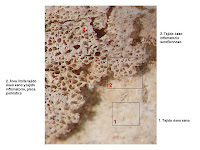Pleuritis en la Valencia romana
Polo Cerdá M. y García-Prósper E.
Grupo Paleolab. Apdo. Correos 6017. 46080 - Valencia. España
REF. González Martín A, Cambra-Moo O, Rascón Pérez J, Campo Martín M, Robledo Acinas M, Labajo González E, Sánchez Sánchez JA (eds.) (2011). Paleopatología: ciencia multidisciplinar (ISBN: 978-84-938635-0-0) pp: 313 - 329.
RESUMEN. En este trabajo se analiza la serie osteoarqueológica de la calle Quart de Valencia que representa a la población que fundó la ciudad a finales del siglo II a. C. La presencia de lesiones compatibles con tuberculosis en la necrópolis fundacional es un hecho que ya se ha constatado con el hallazgo de varios ejemplos de Mal de Pott en individuos que presentaban un ritual de enterramiento en posición de decubito prono. A la vista de estos hallazgos, en este trabajo se ha realizado una aproximación a la prevalencia de patología infecciosa costal desde un punto de vista diacrónico. Las lesiones descritas vienen a confirmar la incidencia de pleuritis en relación con factores exógenos infecciosos (tuberculosis) y/o ambientales desde la fundación de la ciudad en el año 138 a. C. hasta el final del Imperio, siendo su prevalencia de 3,42% de la población, alcanzándose hasta un 6,28% de lesiones óseas atribuibles a tuberculosis.
PALABRAS CLAVE: pleuritis, periostitis, tuberculosis, Valentia, época romana
SUMMARY. In this work, osteoarchaelogical remains from the Quart Street in Valencia has been analysed. These remains represent the population who founded Valencia towards the end of the 2nd century BC. The presence of compatible lesions with tuberculosis within the original necropolis is a fact that has been recognized by the findings of various cases of Pott disease. These individuals were found in decubito prono position what represent a burial ritual. In view of these discoveries, this work has put forward a diachronic approach to examining the prevalence of costal infectious pathologies. The lesions described confirm the occurrence of pleurisy related with infectious exogenous factors (tuberculosis) and/or environmental factors since the city foundation, around the year 138 BC. until the end of the Empire. Its prevalence rate stood at 3.42% of the population and reached 6.28% for bone lesions attributable to tuberculosis.
KEYWORDS: Pleurisy, periostitis, tuberculosis, Valentia, Roman period


